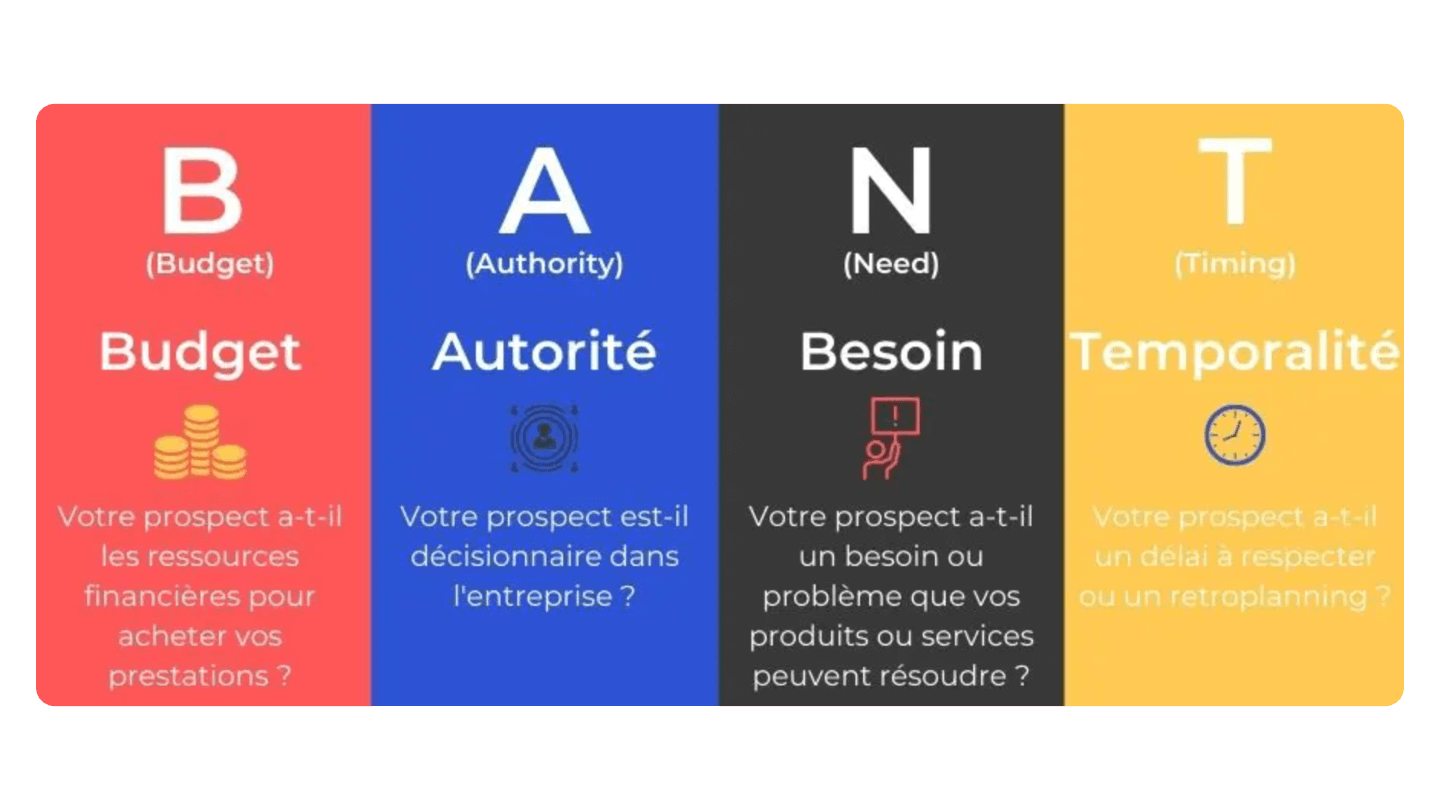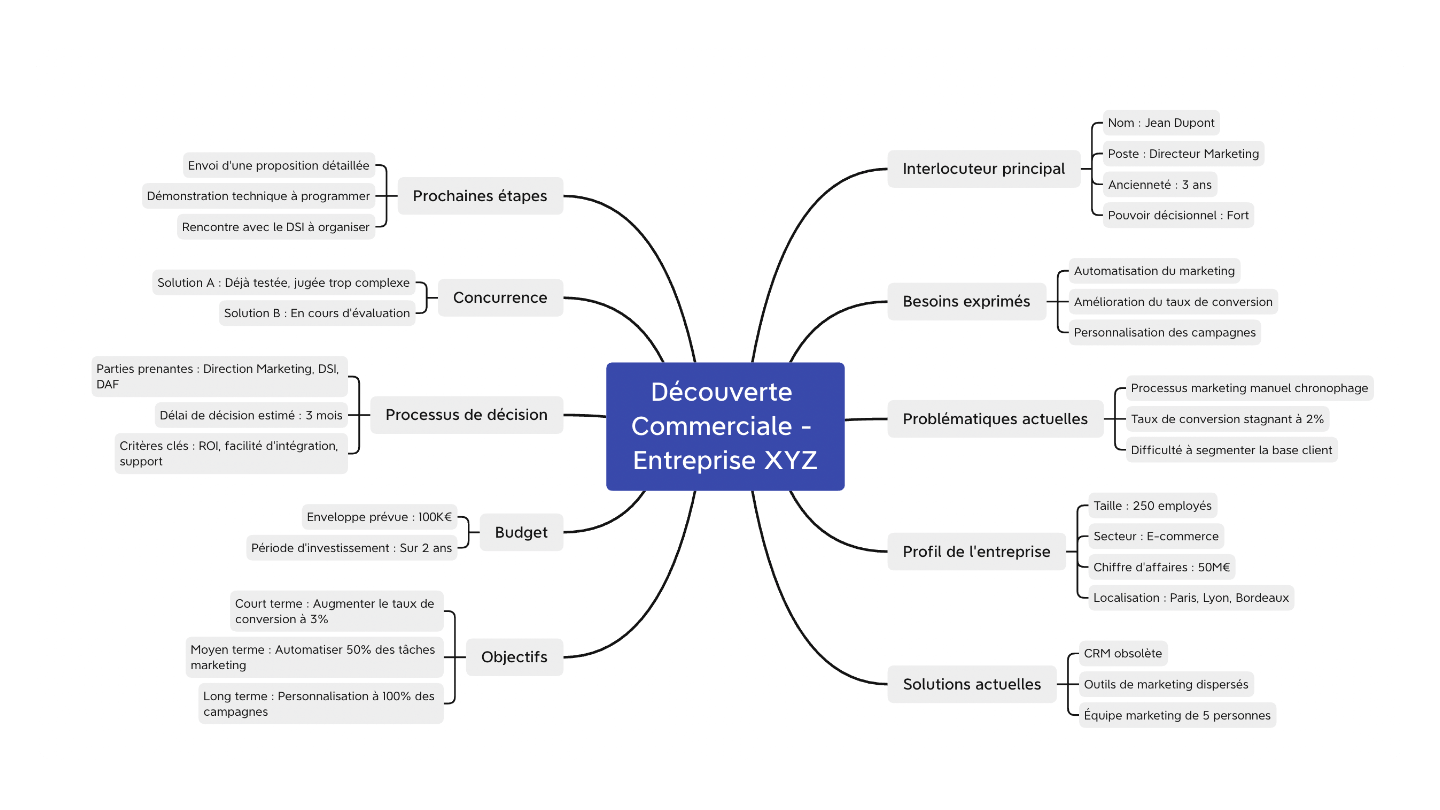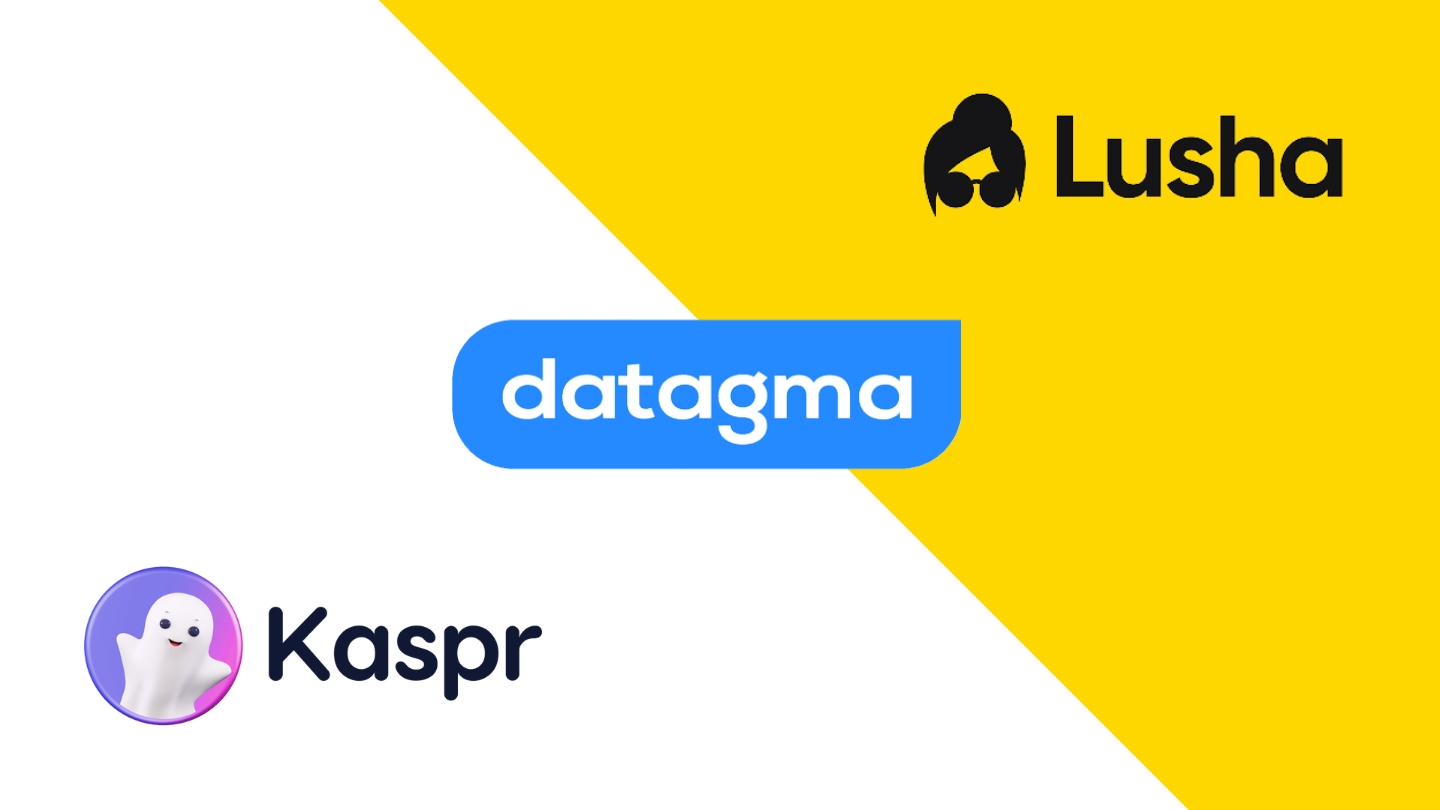Looking to improve your sales techniques?
You’re right to take an interest in sales discovery.
It’s the step that can make all the difference between a prospect slipping through your fingers and a loyal customer.
But sales discovery isn’t just about asking your prospect a few loaded questions.
If you’re here, it’s because you know there’s real know-how to be acquired.
And you’re right!
Too many salespeople launch headlong into their sales pitch without taking the time to really understand their contact’s needs.
The result?
Conversations that go round in circles, objections that fly, and sales that go down the drain.
In this article, we’ll take a look at the secrets of successful sales discovery.
We’ll look at how :
- Asking the right questions (and, above all, how to formulate them)
- Really listen to what your prospect says (and doesn’t say)
- Analyze the information gathered to prepare an effective sales pitch
Whether you’re a seasoned entrepreneur or just starting out in sales, here you’ll find practical techniques for turning your sales discoveries into real selling machines.
Sommaire
Commercial discovery objectives
We’re often told that sales discovery is a key phase in the sales process.
But why exactly?
Here are the main objectives:
- Understanding the prospect’s needs.
It’s a no-brainer, you might say.
But you’d be surprised how many salespeople miss the point.
It’s not just a question of asking “What are your needs?
No, the challenge here is to dig deeper, to unearth needs that the prospect isn’t even aware of.
That’s where it gets interesting! - Establish a relationship of trust.
You can’t buy from just anyone, can you?
Commercial discovery is your chance to show that you’re not just there to sell your product, but that you’re genuinely interested in your prospect’s problems. - Qualifying the prospect.
It’s a fact that not all prospects are created equal.
Commercial discovery allows you to sort the wheat from the chaff.
Budget, authority, need, timing (BANT for short): that’s what you need to assess.
It’ll help you avoid wasting your time on prospects who will never convert.

- Preparing the sales pitch.
Just imagine: you’ve got all the information you need to tailor your sales pitch.
It’s a game-changer, isn’t it?
That’s exactly what good sales discovery does.
No more generic pitches that speak to no one… - Define next steps.
A successful sales discovery always concludes with a clear Sales Action Plan.
Whether it’s a demo, a sales proposal or a new appointment, you need to know where you’re going.
And so does your prospect!
In short, mastering commercial discovery means moving from the status of a simple salesperson to that of a true partner for your customers.
And that, believe me, changes everything in your sales approach!
When and how to conduct a commercial discovery
Commercial discovery is not a one-off event, but an ongoing process that takes place at various stages of your customer relationship.
It begins with the first phone call, where you can already glean valuable information in just a few minutes.
This first exchange enables you to qualify the prospect and prepare the ground for a more in-depth discovery.
Which leads to the next point.
The physical meeting remains the ideal context for a complete discovery.
In the sales prospecting phase, nothing beats a face-to-face meeting to create a real bond and delve deeper into your prospect’s needs.
Allow at least 30 minutes, or even an hour, for a complete discovery.
Of course, it’s impossible not to mention videoconferencing, which is now widespread.
It’s almost as effective as face-to-face learning, without the constraints of travel.
Just remember to take care of your background and your connection…You may also be interested in this article: How to sell by videoconference? Don’t forget that discovery continues even after you’ve signed.
Your regular follow-ups with your customers are opportunities to deepen your understanding of their needs and uncover new sales opportunities.
Whatever the stage, good preparation is the key to success.
- Before each discovery, do your homework.
Find out all you can about the company, the sector, the potential issues.
You’ll avoid asking stupid questions, and your interviewer will be impressed. - Structure your interview, but remain flexible.
A framework will help you cover all the essential points, but the conversation must remain natural and fluid.
Adapt to your prospect’s answers, and dig into interesting topics, even if they don’t feature in your initial plan. - During the interview, focus on active listening.
Your aim is to get the prospect talking, not to monopolize the conversation.
Pay attention not only to words, but also to body language and unspoken words. - Finally, never leave a meeting without clearly defining the next steps.
Whether it’s a new appointment, a proposal or a demonstration, make sure everyone is aligned on the next step.
Going further
Effective questioning techniques
The art of asking the right questions lies at the heart of successful sales discovery.
It’s not just a matter of questioning your prospect, but of getting him to reveal his true needs, sometimes even those of which he is unaware.
Always start with open-ended questions.
Questions that begin with “How”, “Why” or “What” are your best ally in getting your prospect to talk.
They open the door to detailed, information-rich answers.
For example, instead of asking “Do you have inventory management problems?”, opt for “How do you currently manage your inventory?”.
Once your prospect begins to open up, apply the funnel technique.
Start with the general and work towards the specific.
You can start with questions about the company as a whole, then focus on the department concerned, and finally address specific issues.
This approach helps to contextualize needs and understand the big picture.
Also, don’t forget that active listening is just as important as the questions themselves.
Sometimes, silence is your best friend.
After an answer, leave a moment of silence.
You’ll be surprised how often the person you’re talking to will speak up again to expand on his or her thoughts or add crucial information.
| Type of question | Description | Example | Benefits |
|---|---|---|---|
| Open questions | Start with “How”, “Why”, “What”. | “How do you currently manage your billing process? | Encourages detailed answers; elicits a lot of information |
| Closed questions | Call for a “yes” or “no” response | “Do you currently use a CRM? | Useful for confirming information; allow you to obtain precise answers |
| Funnel questions | From the general to the specific | “Can you tell me about your company? … What about your marketing department?”” |
Enables contextualization and progressive deepening |
| Projection questions | Make you imagine an ideal future situation | “In a perfect world, how would you see this process working? | Helps identify the prospect’s latent needs and aspirations |
| Rephrasing questions | Repeat or summarize what the prospect has said | “If I understand correctly, your main challenge is…” | Shows you’re actively listening; Clarifies and confirms understanding |
| Probing questions | Dig deeper into a point mentioned by the prospect | “That’s interesting what you’re saying there. Can you tell me more about it? |
Provides crucial details on an important point |
| Quantification questions | Aim to obtain precise figures | “How much do you think you could increase your productivity with the right solution? | Helps you quantify the potential ROI of your solution |
Here are a few additional tips for effectively questioning your prospects during the sales discovery phase:
- Reformulation.
Rephrasing is another powerful technique.
Not only does it show that you’re paying attention, but it can also be used to check your understanding and probe certain points.
A simple “If I understand correctly, your main challenge is…” can open the door to important clarifications. - Projection questions.
To really understand what’s at stake, don’t hesitate to use projection questions.
Ask your prospect how he or she would imagine the ideal situation.
This technique gives you valuable pointers for your future proposal, and enables your contact to project himself into a future where your solution solves his problems. - probing questions.
Finally, don’t be afraid to dig deeper.
When your prospect mentions something interesting, dig deeper.
A simple “That’s interesting what you’re saying there. Can you tell me more about it?” can reveal key information for your sale.
How to analyze and use the information gathered
Okay, you’ve conducted your discovery like a boss.
You’ve got a mountain of information.
Now what do we do with it all?
Let’s go!
- Sort through your notes.
Start by rereading your notes with a clear head.
Highlight key information, important figures and quotations.
In short, get the gist of your interview. - Identify explicit and implicit needs.
Has your prospect clearly told you what he wants?
Great, those are the explicit needs.
But don’t stop there!
Look between the lines for needs he may not even be aware of.
That’s where you’ll make the difference. - Prioritize problems.
Not all problems are created equal.
Some are urgent, others less so.
Some cost millions, others peanuts.
Make a top 3 list of priority issues for your prospect.
These are the ones you’re going to focus on. - Match needs with solutions.
For each identified need, think about how your offer can meet it.
Be specific: which functionality for which need?
Which service for which problem?
That’s how you’ll build a solid sales pitch. - Estimate the potential impact. If possible, try to quantify the benefits your solution could bring.
“Our tool could save you X hours a week, or Y€ a year”.
Now that’s talking to decision-makers! - Anticipate objections.
By analyzing your notes, you can often guess the objections that will arise.
Price too high?
Fear of change?
Anticipate them and prepare your counter-arguments.
You won’t be caught off guard. - Prepare your storytelling.
Numbers are good, stories are better.
Use the anecdotes and concrete examples your prospect has given you to illustrate how your solution will transform their daily lives.
There’s no better way to leave a lasting impression! - Define your follow-up strategy.
Based on what you’ve learned, what’s the best next move?
A personalized demo?
A customized proposal?
Another meeting with other decision-makers?
Define your plan of attack. - Share the news with your team.
If other people in your company are involved in the process (tech, marketing, etc.), debrief them.
The more everyone is aligned, the more effective you’ll be in closing the sale. - Keep track in your CRM software.
Last but not least: record all this information in your CRM.
It’ll be invaluable for follow-up, and will enable anyone in your team to pick up the file if need be.
Now you know how to turn your mountain of notes into a commercial goldmine.
So, are you ready to take action?
Tools and resources to optimize Business Discovery
Here’s an overview of the must-have tools and resources that can dramatically improve your performance during the sales discovery phase.
| Resource & Tool | Description |
|---|---|
| CRM software | The heart of your sales arsenal. Solutions such as Salesforce, HubSpot or Pipedrive enable you to centralize all your prospect and customer information. You can log every interaction, note key discovery information and track the progress of your opportunities. A good CRM gives you an overview of your pipeline and helps you leave nothing to chance. It’s a salesperson’s basic tool. |
| Intelligent note-taking tools | Evernote, Notion or OneNote are transforming the way you capture and organize information during your discoveries. These tools let you structure your notes, integrate multimedia elements and synchronize them with your CRM. No more illegible notes on a napkin! On this subject, read our article:“Top 12 alternatives to Evernote“. |
| Video conferencing software | Zoom, Microsoft Teams or Google Meet have become indispensable for remote discovery. A word of advice: choose a solution that allows you to record calls: being able to review your meeting gives you a second chance to capture details you might have missed at the time. In parallel, you can use a meeting summary tool to access reports of your visios. There are lots of them out there, and I particularly recommend Fireflies. |
| Voice analysis tools | Solutions like Gong.io or Chorus.ai analyze your discovery calls to provide valuable insights. They can measure your speaking time, identify the keywords used and even suggest areas for improvement. It’s like having a personal coach analyze your every performance. |
| B2B databases | ZoomInfo or LinkedIn Sales Navigator give you access to a wealth of information about your prospects even before your first contact. These tools enable you to arrive prepared for your discoveries, with an in-depth understanding of the company, its sector and the challenges it may face. |
| Interactive questionnaires | Tools such as Typeform or SurveyMonkey enable you to create interactive and engaging discovery questionnaires. Ideal for a first approach or to supplement your information between appointments, these questionnaires can help you collect valuable data systematically and efficiently. |
| Mind Mapping tools | MindMeister or XMind help you visualize and organize all the information you’ve gathered during your discoveries. These tools are handy for making links between your prospect’s different needs and for getting a clear overview of his or her situation. They can also be used collaboratively during your interviews. |
However, used wisely, they can really improve the quality and effectiveness of your commercial discoveries.
Remember, the best technology in the world is worthless without a solid strategy and a sincere desire to understand and help your prospects.
Measure the effectiveness of your commercial discoveries
So, you’re leading your discoveries like a boss.
But how do you know how effective you really are?
That’s where measurement comes in.
And no, it’s not just a boring trick to keep your boss happy.
Here’s a list of the main indicators to scrutinize (the famous KPIs) to measure the performance of your commercial discovery:
- Discovery conversion rate > proposal.
It’s basic, but it doesn’t lie.
Out of 10 discoveries, how many turn into concrete proposals?
If it’s less than 5, there may be a problem somewhere. - Conversion rate: > sales.
A little further down the tunnel.
This KPI is even more revealing: if your proposals don’t turn into sales, it may be that your discovery wasn’t all that solid. - Average length of discovery phases.
Too short, and you may miss crucial information.
Too long, and you risk boring your prospect.
Find the right balance. - Number of needs identified per discovery.
The more relevant needs you identify, the greater your chances of closing the sale.
It’s a good exercise.
Aim for at least 3 clear needs per discovery. - Qualification score.
A good practice is to create a scoring system to evaluate the quality of your leads after discovery.
Choose the right criteria.
Budget, Authority, Need, Timing (BANT), you know the drill. - Prospect feedback.
Really, dare to ask your prospects what they thought of your discovery.
Feedback may not always please, but it’s always highly instructive. - Surprise” rate during the closing phase.
How often do you hear “Ah, but I didn’t know that…” at the moment of closing?
If it’s too frequent, your discovery has holes. - Time between discovery and sale.
The shorter this time, the more effective your discovery was probably.
If it takes too long, something’s wrong.
And remember: measuring is good, acting is better.
Use these metrics to constantly improve.
There’s no such thing as a perfect discovery, but you can always come close.
Conclusion
You’re there!
You now have all the tools you need to turn your sales discoveries into real conversion machines.
From preparation to analysis, questioning techniques and mistakes to avoid, you’ve got everything you need to shine.
Remember, sales discovery isn’t just a mandatory step, it’s THE key moment that can turn a simple contact into a successful sale.
It’s where you lay the foundations of your customer relationship, demonstrate your added value, and set yourself apart from the competition.
So now it’s up to you!
Put these tips into practice, test these tools, measure your performance.
And above all, never forget: good sales discovery is 20% technique and 80% active listening and empathy.
Your aim is not to sell at any price, but to really understand your prospect’s needs and provide real added value.







